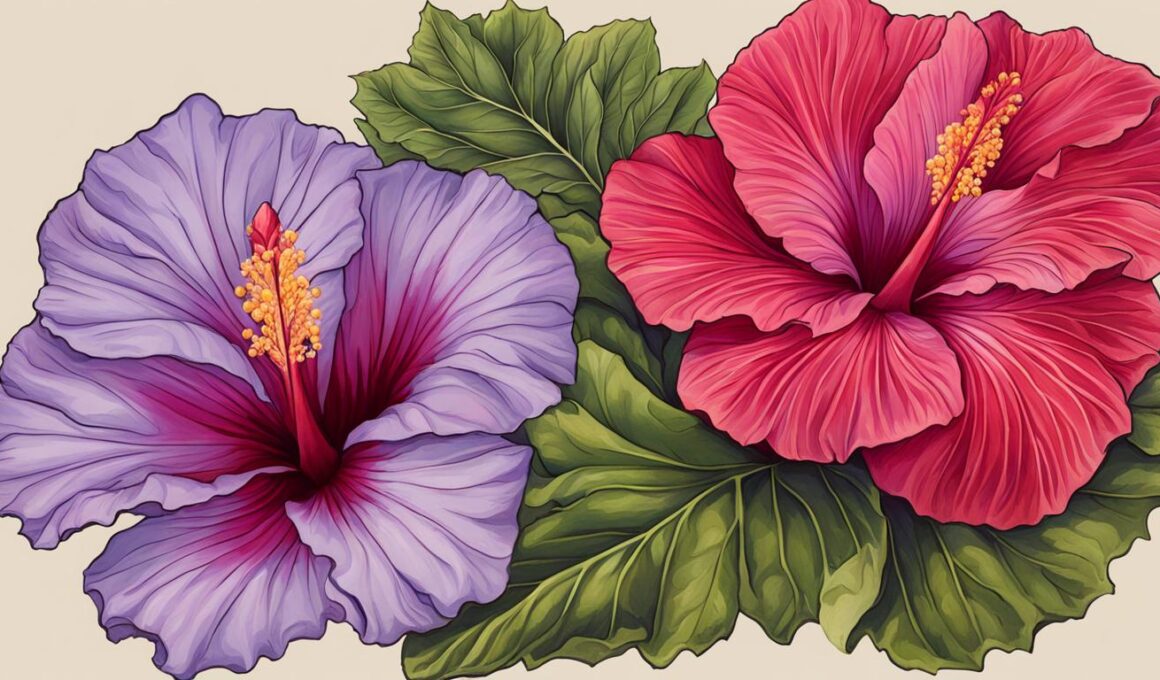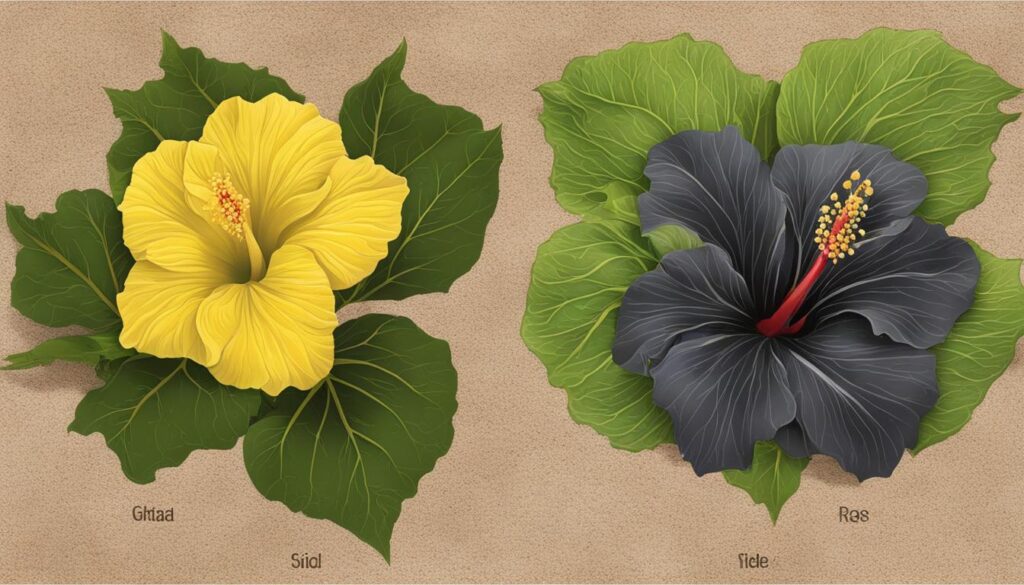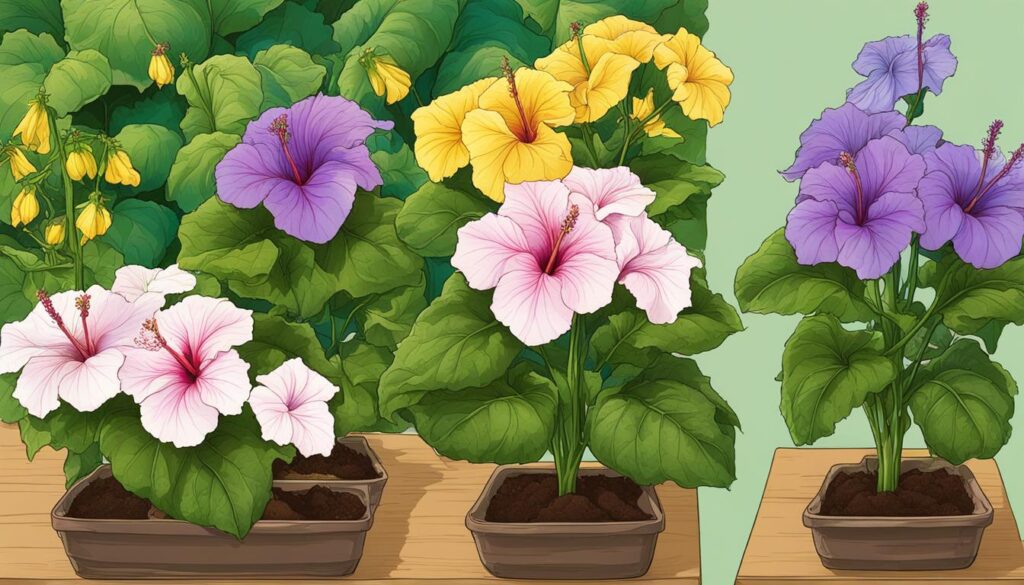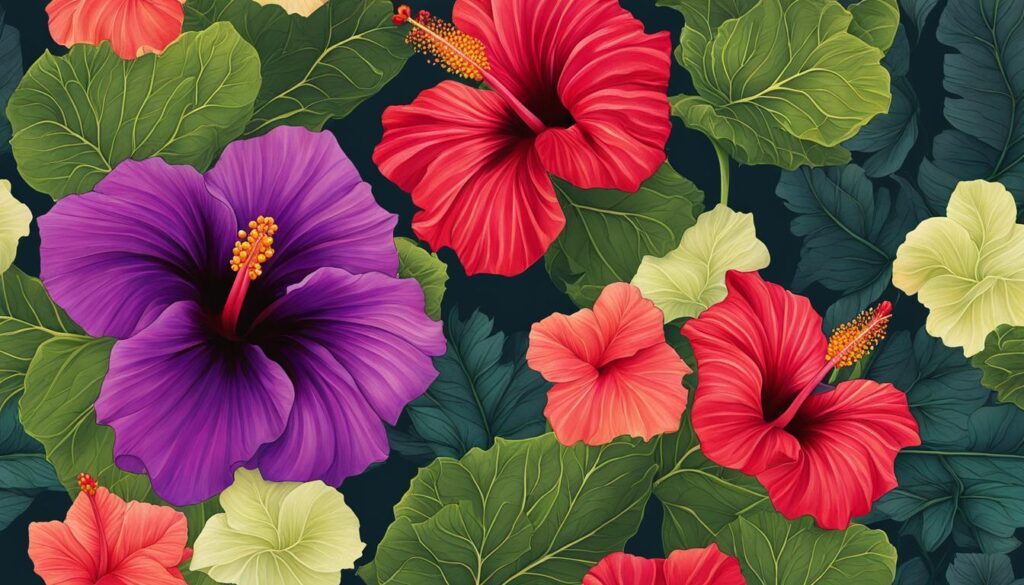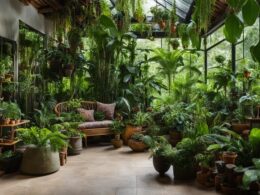The Brassica flower and the Hibiscus flower are both popular plants known for their beautiful blooms. However, they belong to different plant families and exhibit distinct characteristics. Understanding their differences can help you make informed decisions when choosing plants for your garden or landscape.
Post Summary
- Brassica and hibiscus flowers are from different plant families.
- Brassica flowers are typically shorter in height compared to hibiscus flowers.
- Soil drainage and light requirements differ for brassica and hibiscus flowers.
- Brassica flowers are known for their wide range of colors, while hibiscus flowers come in various shades.
- Bloom time and ideal growing conditions vary for brassica and hibiscus flowers.
Genus and Family
When comparing the Brassica flower and the Hibiscus flower, it’s important to understand their respective genus and family. The Brassica flower belongs to the Brassicaceae family, which consists of over 350 genera. This family includes popular vegetables like cabbage, broccoli, kale, brussels sprouts, and cauliflower. On the other hand, the Hibiscus flower is a member of the Malvaceae family. The hibiscus genus comprises several hundred species found in warm-temperate, subtropical, and tropical regions worldwide.
| Flower | Genus | Family |
|---|---|---|
| Brassica | Brassica | Brassicaceae |
| Hibiscus | Hibiscus | Malvaceae |
The Brassicaceae family, often referred to as the mustard family, encompasses a wide range of flowering plants with diverse characteristics. In contrast, the Malvaceae family, also known as the mallow family, includes various herbaceous plants and shrubs. Understanding the genus and family of each flower provides valuable insight into their botanical classification and relationships with other plant species.
Both the Brassica flower and the Hibiscus flower have unique characteristics that contribute to their beauty and desirability in gardens and landscapes. By delving deeper into their genus and family, we gain a better understanding of their place in the plant world and the distinct traits that set them apart.
Species and Life Cycle
Understanding the species and life cycle of the Brassica flower and the Hibiscus flower is essential for successful cultivation. Brassica flowers, including cabbage, broccoli, and kale, are typically biennial or perennial plants. This means that they take two seasons to produce seeds and may require cold treatment to flower. On the other hand, hibiscus flowers can be either annuals or perennials, with some tropical varieties only growing in specific USDA plant hardiness zones.
Knowing the life cycle of these flowers allows you to plan and maintain your garden more effectively. Brassica flowers, with their biennial or perennial nature, require more patience and careful management. You can expect these flowers to bloom every other year or even in subsequent years if they are perennials. Hibiscus flowers, on the other hand, offer more flexibility as they can be annuals or perennials, giving you the option to change your garden design every year or create a more permanent landscape.
Life Cycle Summary:
- Brassica flowers: biennial or perennial
- Hibiscus flowers: annual or perennial, variety-dependent
Understanding the life cycle of Brassica and hibiscus flowers enables you to plan your garden based on their growth patterns and adaptability. Whether you opt for the long-term commitment of the biennial or perennial Brassica flowers or the more flexible annual or perennial hibiscus flowers, both species offer unique beauty and possibilities in your garden.
By understanding the soil drainage and light requirements of brassica and hibiscus flowers, you can create an environment that promotes their healthy growth and vibrant blooms. Whether you have a sunny garden or a partially shaded area, there’s a flower option for you to enjoy the beauty and benefits they bring to your outdoor space.
pH Requirements and Propagation
Understanding the pH requirements of your plants is essential for their healthy growth and development. Brassica flowers prefer a pH range of 6.0 to 8.0, indicating a slightly acidic to neutral soil environment. On the other hand, hibiscus flowers thrive in slightly acidic soil with a pH of 6.5 to 6.8. Maintaining the appropriate pH levels will ensure that your brassica and hibiscus flowers are able to absorb essential nutrients effectively.
Both brassica and hibiscus flowers can be propagated from seeds, making it relatively easy to expand your garden or share these beautiful flowers with others. When propagating brassica flowers, it’s important to sow the seeds in well-prepared soil, ensuring proper moisture and temperature conditions. As for hibiscus flowers, they can be grown from seeds or vegetative cuttings. Keep in mind that propagating hibiscus from cuttings may result in faster and more consistent growth, allowing you to enjoy their vibrant blooms sooner.
Propagation Methods
To propagate brassica flowers:
- Prepare the soil by removing any weeds and loosening it with a garden fork.
- Sow the seeds at the recommended depth, usually about ¼ to ½ inch deep.
- Water the soil gently, ensuring that it stays moist but not waterlogged.
- Provide adequate sunlight and maintain the appropriate pH levels for optimal growth.
To propagate hibiscus flowers:
- Obtain a healthy hibiscus plant or take cuttings from an existing hibiscus plant.
- Prepare a rooting medium by using a mixture of perlite and peat moss.
- Remove any leaves from the lower half of the cutting and dip it in rooting hormone.
- Plant the cutting in the rooting medium and water the soil lightly.
- Place the cutting in a warm and humid environment, ensuring indirect sunlight.
By following these propagation methods, you can easily expand your collection of brassica and hibiscus flowers and create a stunning display in your garden.
Maintenance and Benefits
Proper maintenance is essential for both Brassica and hibiscus flowers to thrive and stay healthy. While Brassica flowers are relatively low-maintenance plants, hibiscus plants require more attention to prevent diseases and ensure optimal growth. Regular care for both flowers includes watering, pruning, fertilizing, and monitoring for pests and diseases.
- Watering: Both Brassica and hibiscus flowers require consistent watering to maintain proper moisture levels in the soil. However, it’s crucial not to overwater them, as excessive moisture can lead to root rot. It’s recommended to water the plants deeply but allow the soil to dry out slightly between waterings.
- Pruning: Pruning helps maintain the shape and size of the plants, promotes better air circulation, and removes dead or damaged branches. For Brassica flowers, removing spent blooms can encourage continuous flowering. Hibiscus plants benefit from regular pruning to remove old wood and promote new growth.
- Fertilizing: Providing adequate nutrients is essential for healthy growth and abundant blooms. You can fertilize both Brassica and hibiscus flowers with a balanced, slow-release fertilizer in the spring. Additionally, hibiscus plants can benefit from a phosphorus-rich fertilizer to enhance flowering.
- Pest and Disease Control: Regular monitoring is key to detect and prevent common pests and diseases that may affect both Brassica and hibiscus flowers. In Brassica flowers, watch out for cabbage loopers, aphids, and slugs. Hibiscus plants are susceptible to pests such as aphids, whiteflies, and spider mites. Proper cultural practices, like maintaining good airflow and cleanliness, can help prevent and manage these issues.
Both Brassica and hibiscus flowers offer a range of benefits beyond their aesthetic appeal. They attract pollinators like bees and butterflies, contributing to a healthy ecosystem in your garden. Additionally, Brassica flowers serve as larval hosts for certain butterfly species, making them valuable contributors to biodiversity. Both flowers also have potential health benefits, as certain Brassica varieties are edible and rich in essential nutrients, while hibiscus flowers are used in herbal teas and traditional medicine.
Brassica and hibiscus flowers provide not only visual beauty but also contribute to the ecological balance of your garden. With proper maintenance and care, these flowers can thrive and bring a range of benefits to both humans and nature. So whether you choose the versatile Brassica flower or the vibrant Hibiscus flower, you’ll have a stunning addition to your garden that supports biodiversity and may even provide some health benefits too.
Height, Width, and Flower Color
When it comes to the physical characteristics of Brassica and hibiscus flowers, there are notable differences in their height, width, and flower color.
Brassica flowers generally have shorter heights, ranging from 0 ft. 10 in. to 2 ft. 0 in., with a width of 1 ft. 0 in. to 2 ft. 0 in. These flowers come in various colors, adding vibrancy to any garden. You can find Brassica flowers in deep rosy violet, crimson white, and emerald green hues.
Hibiscus flowers, on the other hand, can be taller, reaching heights of 15 ft., though they rarely exceed 6.5 ft. in most cases. With a width of 3-5 feet, hibiscus flowers create a stunning visual impact. The flower colors of hibiscus include yellow, white, burgundy, red, pink, and lavender, making them a true spectacle in any landscape.
| Height | Width | Flower Color | |
|---|---|---|---|
| Brassica Flower | 0 ft. 10 in. to 2 ft. 0 in. | 1 ft. 0 in. to 2 ft. 0 in. | Deep rosy violet, crimson white, emerald green |
| Hibiscus Flower | Up to 15 ft. (Rarely surpasses 6.5 ft.) | 3-5 feet | Yellow, white, burgundy, red, pink, lavender |
As you can see, both Brassica and hibiscus flowers offer a delightful variety of colors and dimensions, allowing you to choose the perfect floral display for your garden or landscape.
Bloom Time and Ideal Growing Conditions
Understanding the bloom time and ideal growing conditions is essential for successfully cultivating brassica and hibiscus flowers. Each flower has its own unique requirements that contribute to their growth and vibrant blooms.
Brassica flowers generally bloom in summer or spring, depending on the specific species and variety. The duration of their bloom can vary, with some varieties producing flowers for several weeks. On the other hand, hibiscus flowers, especially perennial varieties, tend to bloom in mid to late summer. Their stunning blooms can last for several months, adding beauty to your garden throughout the season.
When it comes to ideal growing conditions, both brassica and hibiscus flowers have some similarities. They both thrive in well-drained soil, ensuring proper root development and preventing waterlogging. However, brassica flowers prefer soil with good drainage, while hibiscus flowers can tolerate slightly more moisture. It’s important to provide them with adequate watering, allowing the soil to dry out between waterings to avoid overwatering.
USDA Plant Hardiness Zone
To determine the suitable plant hardiness zone for growing Brassica flowers and Hibiscus flowers, you need to consider the United States Department of Agriculture (USDA) plant hardiness zone map. This map divides the United States into different zones based on the average annual minimum temperature. It helps gardeners identify the plants that are most likely to thrive in their specific regions.
Brassica flowers are typically hardy in USDA plant hardiness zones 6 to 9. These zones cover various regions across the United States, including parts of the Midwest, Northeast, South, and West Coast. If you reside in one of these zones, you can confidently grow Brassica flowers in your garden or landscape.
Hibiscus flowers, on the other hand, have different hardiness requirements. Tropical hibiscus varieties, known for their vibrant blooms, are typically grown in USDA plant hardiness zones 9 and 10. These zones are found in the southernmost parts of the United States, such as Florida and Hawaii, where the temperatures remain warm throughout the year. Hardy perennial hibiscus varieties, which are more cold-tolerant, thrive in zones 5 to 9, covering a larger area of the country.
USDA Plant Hardiness Zone Map
The USDA Plant Hardiness Zone map divides the United States into different zones based on the average annual minimum temperature. This map is useful for gardeners to determine which plants are most likely to thrive in their specific regions. Below is the USDA Plant Hardiness Zone map for reference:
| Zone | Minimum Temperature |
|---|---|
| Zone 1 | Below -50°F (-45.6°C) |
| Zone 2 | -50°F to -40°F (-45.6°C to -40°C) |
| Zone 3 | -40°F to -30°F (-40°C to -34.4°C) |
| Zone 4 | -30°F to -20°F (-34.4°C to -28.9°C) |
| Zone 5 | -20°F to -10°F (-28.9°C to -23.3°C) |
| Zone 6 | -10°F to 0°F (-23.3°C to -17.8°C) |
| Zone 7 | 0°F to 10°F (-17.8°C to -12.2°C) |
| Zone 8 | 10°F to 20°F (-12.2°C to -6.7°C) |
| Zone 9 | 20°F to 30°F (-6.7°C to -1.1°C) |
| Zone 10 | 30°F to 40°F (-1.1°C to 4.4°C) |
| Zone 11 | Above 40°F (4.4°C) |
Tips for Growing and Caring for Brassicas
Brassicas, including cabbage, broccoli, kale, brussels sprouts, and cauliflower, are versatile plants that can thrive in many gardens. Whether you’re a seasoned gardener or just starting, these tips will help you grow and care for your brassicas successfully.
1. Choosing the Right Location
Brassicas require full sun to thrive, so choose a location in your garden with at least six hours of direct sunlight per day. Additionally, make sure the soil is well-drained to prevent waterlogging, which can lead to root rot.
2. Preparing the Soil
Before planting your brassicas, prepare the soil by adding organic matter such as compost or well-rotted manure. This will improve the soil’s fertility and drainage, providing a nutrient-rich environment for your plants to grow.
3. Proper Watering
Brassicas need consistent moisture, so water them regularly to keep the soil evenly moist. Avoid overwatering, as this can lead to disease and root rot. Mulching around the plants can help retain moisture and suppress weeds.
4. Pest and Disease Management
Brassicas are prone to common pests like cabbage worms, aphids, and flea beetles. Monitor your plants regularly and take action at the first sign of infestation. You can use organic pest control methods, such as handpicking pests or applying insecticidal soap. Additionally, practice crop rotation to minimize the risk of disease buildup in the soil.
By following these tips, you can ensure the successful growth and care of your brassicas. Happy gardening!
Conclusion
In conclusion, the Brassica flower and the Hibiscus flower have distinct differences in terms of their genus, family, species, life cycle, soil drainage, light requirements, pH requirements, propagation, maintenance, benefits, height, width, flower color, bloom time, ideal growing conditions, and USDA plant hardiness zone.
Both flowers have their unique characteristics and can be a beautiful addition to any garden or landscape. Whether you prefer the sturdier and versatile Brassica flower or the vibrant and tropical Hibiscus flower, they will undoubtedly enhance the beauty of your surroundings.
So, whether you’re a gardening enthusiast or simply looking to add some color to your outdoor space, consider the distinct qualities of the Brassica and Hibiscus flowers. With their diverse characteristics and unique charm, they offer a wide range of options to suit your preferences and create a visually stunning garden.
What is the Difference Between the Flowers of Brassica and Hibiscus Plants?
The brassica plant flowering period typically occurs in the late spring to early summer, while hibiscus flowers bloom throughout the summer and into the fall. The main difference lies in the timing of their flowering periods, as well as the physical appearance of their flowers.
FAQ
What is the main difference between Brassica and hibiscus flowers?
The main difference lies in their genus, family, species, life cycle, soil drainage, light requirements, pH requirements, propagation, maintenance, benefits, height, width, flower color, bloom time, ideal growing conditions, and USDA plant hardiness zone.
Which plant family does Brassica belong to?
Brassica is a member of the Brassicaceae family, which includes plants like cabbage, broccoli, kale, brussels sprouts, and cauliflower.
What family does hibiscus belong to?
Hibiscus belongs to the Malvaceae family.
Are Brassica flowers biennial or perennial?
Brassica flowers are usually biennial or perennial.
What type of flowers can hibiscus be?
Hibiscus flowers can be annual or perennial, depending on the variety.
What are the light requirements for Brassica flowers?
Brassica flowers thrive in full sun and require at least six hours of direct sunlight per day.
Can hibiscus tolerate partial shade?
Yes, hibiscus flowers can tolerate partial shade and require around 2-6 hours of direct sunlight during the day.
What is the pH range preferred by Brassica flowers?
Brassica flowers prefer a pH range of 6.0 to 8.0.
What pH range is ideal for hibiscus flowers?
Hibiscus flowers thrive in slightly acidic soil with a pH of 6.5 to 6.8.
How can Brassica and hibiscus be propagated?
Both Brassica and hibiscus can be propagated from seeds. Hibiscus can also be grown from vegetative cuttings.
Are Brassica flowers low-maintenance?
Yes, Brassica flowers are relatively low-maintenance plants.
Do hibiscus plants require special care?
Yes, hibiscus plants require proper care to prevent diseases.
What are the benefits of Brassica and hibiscus flowers?
Both flowers attract pollinators, serve as wildlife larval hosts, and potentially provide health benefits when consumed.
What is the typical height and width of Brassica flowers?
Brassica flowers have shorter heights ranging from 0 ft. 10 in. to 2 ft. 0 in., with a width of 1 ft. 0 in. to 2 ft. 0 in.
How tall can hibiscus flowers grow?
Hibiscus flowers can reach heights of 15 ft., rarely exceeding 6.5 ft., with a width of 3-5 feet.
What are the common flower colors for Brassica and hibiscus?
Brassica flowers can vary from deep rosy violet to crimson white and emerald green. Hibiscus flowers are available in yellow, white, burgundy, red, pink, and lavender colors.
When do Brassica flowers bloom?
Brassica flowers generally bloom in summer or spring.
When do hibiscus flowers typically bloom?
Hibiscus flowers, especially perennial varieties, tend to bloom in mid to late summer.
What are the ideal growing conditions for Brassica and hibiscus flowers?
Brassica and hibiscus flowers thrive in various environments, including containers, coastal areas, patios, meadows, and small spaces.
What is the USDA plant hardiness zone for Brassica flowers?
Brassica flowers are typically hardy in USDA plant hardiness zones 6 to 9.
What are the USDA plant hardiness zone requirements for hibiscus flowers?
Hibiscus flowers have different hardiness requirements, with tropical varieties growing in zones 9 and 10, while hardy perennial hibiscus thrives in zones 5 to 9.
How can I grow and care for brassicas?
To grow and care for brassicas, it’s important to provide well-drained and moist soil, adequate spacing, proper watering, and partial sunlight. It’s also essential to be aware of common pests and diseases and take appropriate measures to prevent and manage them.





